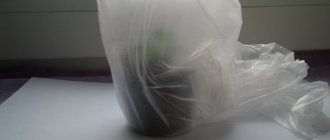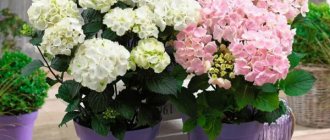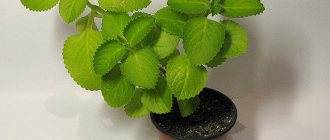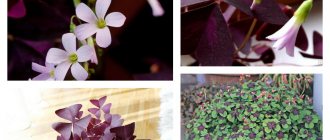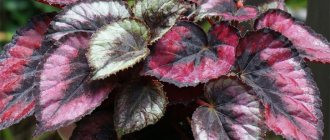Description of indoor gerbera
The plant reaches 25-55 cm in height. In this case, maximum growth is possible during the flowering period due to the formation of a peduncle from a leaf rosette. At its top a basket blooms no more than 14 cm in diameter. During flowering, the petals can be of any color. There are types with pink, white, burgundy and other shades.
The leaves are arranged in several tiers on small petioles. They have a pinnately dissected shape, the central part is more elongated. The leaf color is dark green. Sometimes there is thick soft pile on the petioles.
Optimal conditions of detention
Gerberas are African flowers; they love it when it’s warm and light. To make them feel comfortable in a pot on the windowsill, it is advisable to create conditions as close to tropical as possible. These include:
- Lighting . You need a lot of light during the day, it directly affects flowering. In the mornings and evenings, gerbera loves to literally bathe in the sun's rays. But if it remains in direct sun all day, the leaves are guaranteed to get burned. In winter, when daylight is short, it should be extended, if possible, with a fluorescent lamp.
- The temperature should be high enough, but not hot. The most comfortable temperature during the flowering period is +20…+25°C. In winter it should be cooler - about +14...+16°С, but not lower than +12°С and not higher than +20°С. The plant reacts poorly to differences in day and night temperatures.
- Air humidity. Gerbera loves moist air (70–80%), so humidifying the air with a spray bottle is necessary in the warm season. The water should be warm. You can spray the leaves and the air around the flower. But you can’t spray: when it’s damp and cold outside, and if direct sunlight falls on the plant. You can’t do without spraying in winter if the air in the room is very dry due to heating. Instead of a spray bottle, you can use a container of water, which should be placed near the pot.
- Soil moisture . The soil should remain slightly moist. The earthen ball should neither dry out completely nor be too wet. If there is a lack of moisture, the leaves of the plant hang limply, but an excess of it is more dangerous, as it can provoke fungal diseases.
Gerbera classification
Two types of plants are popular - jamesona and green-leaved. Basically all the indoor ones were bred from the first grade.
| Type, petals | Inflorescences | Variety, flowers |
| Small-flowered, narrow | Small flowers up to 9 cm in diameter. | Aldebaran is pink. Alkar is a shade of ripe cherry. |
| Large-flowered, narrow | Reach 13 cm. | Vega - orange. Jupiter - bright yellow. Algol – ripe cherry. |
| Large-flowered, medium | Medium diameter. | Mars is red. |
| Large-flowered, wide | Large up to 15 cm. | Delios, Markal - sunny color. |
| Terry, narrow | Medium size up to 11 cm. | Kalinka - yellow shades. Viola – rich pink. Sonya - red tones. |
| Terry, wide | Large ones. | Spark - bright, deep red |
The soil
To grow gerbera you will need light, slightly acidic nutrient soil. The optimal composition for it is: leaf soil, peat, sand or sphagnum moss in a ratio of 2:1:1. You can add a little pine bark. An important point - there should be no organic matter (humus, compost) in the soil for gerberas!
In its homeland of South Africa, gerberas grow in soils that are almost devoid of organic matter but rich in minerals.
The soil mixture of the specified composition is sufficiently permeable and fertile. It contains a minimum of organic nutritional compounds that this flower does not tolerate. Also, this soil composition will provide air access to the roots of the plant, which is very important for its proper development.
Gerbera is very demanding on the composition of the soil. To avoid harming the flower when mixing the soil with your own hands, it is better to buy a ready-made soil mixture for gerberas at a flower shop.
Care for gerbera at home
The plant, which is native to South Africa, requires conditions approximately similar to its natural habitat. By following the rules, you can increase the duration of flowering.
| Factor | Spring Summer | Winter | Autumn |
| Location | Place it on the window sill on the east or west side. The room must be ventilated every day. In summer they are moved outside or transplanted into open ground. | ||
| Lighting | Place in a shaded place. | Fluorescent or phytolamps are used to provide the plant with light. | |
| Temperature | Does not tolerate heat above +30…+32 °C. The leaves are withering. | At +12…+14 °C the flower goes into hibernation, flowering is impossible during this period. However, temperatures lower than this may kill the plant. | The normal temperature is +20…+24 °C. |
| Humidity | Requires a humidity of 70-80%, so in the summer the area around it is sprayed. | ||
| Watering | Moderate, as the right layer of soil dries out. Water at room temperature (+20…+22 °C). If necessary (in summer, when placed near a battery), spray the space near the plant or place a humidifier nearby. | ||
| Top dressing | Nitrogen fertilizer is suitable in February, July-August, and during flowering - potassium fertilizer. The solution is first diluted with water, and the soil is watered in a small amount. | ||
Planting, replanting, soil for gerberas
Replanting a plant begins with choosing a pot. It should be clay, this allows the gerbera roots to breathe and maintain the required soil temperature.
You can replant two weeks after purchasing the flower. This allows the plant to get used to new conditions.
Experienced gardeners also recommend:
- choose a pot twice the size of the old one;
- treat the container with boiling water;
- replace all the soil and shake off the roots;
- if the plant is young, then fertilize every 5-7 days.
Jemson
For planting, light, slightly acidic soil is used. You can make it yourself (2:1:1):
- deciduous soil;
- peat;
- sand.
Expanded clay or pine bark as filler.
Replant during dormancy, when gerbera does not bloom. In this case, the root rosette is left to protrude from the ground by 1-2 cm.
Gerberas: planting and growing in the garden
You won’t surprise anyone with blooming gerberas in the garden. Gardeners have learned to propagate and grow tropical flowers in different climatic zones. A popular variety of garden gerbera is Jameson's gerbera, on the basis of which many varieties of flowers for growing in open ground have been bred.
Gerbera Garvinea, unique in its properties, is resistant to disease and is suitable for the climate of Eastern Europe, as its creators found out. Amateur gardener Svetlana Zaslavskaya shares their interesting experience in growing Dutch gerbera varieties.
How to plant in open ground
Garden gerberas are propagated by seedlings or vegetatively (by cuttings, dividing the bush). Seeds for seedlings are sown in the fall or in January–March. Seedlings are grown indoors, planted in separate pots or cassettes. Only in May, after the onset of real warmth, are the seedlings sent to the flowerbed.
The famous florist Yana Fedorova uses a unique method of sowing gerbera seeds. Gerbera seeds hatch the very next day thanks to a radical method - watering with hot boiling water.
Gerberas sown with seeds begin to bloom 10–11 months after planting. They may lose varietal properties, so it is better to use the vegetative propagation method:
- Dividing the bush is used to rejuvenate perennial bushes and propagate your favorite gerbera variety. A 3-4 year old flower with a well-developed root system is suitable for this. It is dug up after flowering ends in August. Using a knife, cut the root into pieces, leaving two growth points on each division (part of the bush). Immediately planted in a permanent place or in pots for indoor growing.
- Cuttings allow you to preserve the varietal characteristics of a flower. It is held from May to July. Cuttings along with roots are cut from a young plant (up to 3 years). The leaves are shortened by 1/3 and the cuttings are planted for rooting in a greenhouse. However, the gardener will have to be extremely careful, because during greenhouse propagation, gerberas, as noted by Professor of the Department of Botany of the Kuban Agrarian University S. S. Chukuridi, develop bacterial and viral diseases.
- Propagation by leaf is easy if you correctly cut the leaf along with the node on the stem. A node is a thickening on the stem from which roots grow. The cut leaf is placed in the ground, covered with a plastic cup with holes for ventilation. After a week, roots will appear and the plant can be transplanted into a growing container.
Gerberas bloom in the garden from July to October. They need to be planted in a lighted area, otherwise they will not bloom. In the shade, the leaves of the plant stretch out and the flower stalks wither.
Gerberas are suitable for loose soil with neutral acidity. If the soil on the site is poor, peat, humus and sand are added to the soil before planting.
Gerberas in the garden: Pixabay
Caring for gerberas in the garden
When planting gerberas as annuals, it is necessary to create conditions for their adaptation:
- make a temporary greenhouse for rooting;
- monitor soil moisture;
- mulch the soil around the root collar;
- loosen the soil and remove weeds.
Perennials need to be uncovered in the spring if they were hidden for the winter. In a lighted area on hot days they need to be shaded so that the leaves and buds do not get burned.
Since gerberas love moderate watering and can be affected by rot if there is an excess of moisture, it is necessary:
- water no more than twice a week;
- increase watering frequency during budding and reduce during flowering;
- use heated, settled water;
- carry out the procedure early in the morning, pouring water at a short distance from the root collar.
After watering and rain, it is advisable to loosen the soil under the flowers to allow oxygen to reach the roots.
Garden varieties of gerberas can be fed only with complex mineral fertilizers prepared according to the instructions. Adding organic matter can cause fungal diseases.
Feeding is applied frequently (once every two weeks):
- nitrogen-containing fertilizers activate the growth of green mass;
- Potassium, phosphorus and calcium have a beneficial effect on gerbera flowering.
The plant will not throw out buds and will not bloom if the area is affected by fungal diseases. The flower urgently needs to be saved by spraying with special chemicals against gray rot, powdery mildew and other diseases.
Preparing for winter
In the southern regions, garden gerberas are grown as perennials, without covering them for the winter. At the end of the season, all flower stalks are broken out of the sockets and the plants are left alone.
If the summer in the region was dry and hot, it is better to cover the gerberas in the fall with straw, spruce branches or dry leaves to retain moisture. Before covering, the flower stalks are cut off at the level of the rosette, and the leaves are also shortened.
In regions with a temperate climate and temperature changes, the flowering of gerberas will be less lush. For the winter, it is better to dig them up, transplant them into pots and keep them indoors. You can store gerberas with a clod of soil in the basement, like dahlias. For successful storage, maintain a temperature of +7–8 °C and a humidity of at least 80%.
Gerberas, thanks to a wide range of colors, become participants in many landscape projects and unusual bouquet arrangements. If all agrotechnical conditions are met, ornamental plants are grown in the house or garden all year round.
Original article: https://www.nur.kz/household/garden/1849332-gerbera-posadka-i-uhod-doma-iv-sadu/
Gerbera propagation
Experts identify two methods for propagating indoor flowers using seeds or dividing the bush.
Using seeds
Suitable for gardeners who want to grow a new variety or propagate gerbera. Seeds are purchased at the store or collected during flowering. For reproduction you will need:
- pour 1-2 cm of soil (a mixture of turf and sand) into the pot;
- lay out the seeds and sprinkle them with soil, but no more than 5 cm;
- cover with film and moisten the soil with a sprayer;
- leave in a warm, bright place;
- Constantly ventilate and moisten until the first leaves;
- After 3-4 leaves appear, divide into small pots.
Dividing the bush
The method is suitable if there is a plant older than two years, it can then be replanted. After dividing, the gerbera is watered and taken to a place where there is no direct sunlight, maintaining a moderate temperature.
Step by step:
- remove the plant from the pot and shake off the roots from the ground;
- divide into 3-4 bushes, leaving two points for growth;
- trim the roots by 10 cm;
- plant the plants in pots and sprinkle with soil;
- rosettes should be 1 cm above the soil.
Green leaf
Soil and pot
The best solution for gerberas would be a clay pot, not covered with glaze - such a container allows air to pass through perfectly and allows the roots to breathe. You can also take plastic containers, but the main condition is that it must breathe.
The soil must remain nutritious and light - there should be no humus or compost in it. Two parts of leaf soil should be mixed with peat and part of river sand.
Reference! If you have difficulty creating suitable soil, you can buy ready-made soil at the store. Just take the right amount and carefully transplant the flower into a new pot.
Errors in care, diseases and pests
Gardeners often make mistakes in caring for gerbera, which leads to its condition worsening. However, if you notice this process in time, you can correct the shortcomings and return the plant to its original appearance.
Typical mistakes in care
| Manifestations | Cause | Corrective measures |
| Yellow leaves | Incorrect watering, too abundant or, on the contrary, scanty. | The water should be at room temperature and watering should be moderate. |
| Withering leaves | Lack of water, dry air. | Spray the plant and water more often. |
| Darkening or fading petals | Lack of light. | Move the pot of gerbera to the sunny side. |
| Dried leaves | Incorrectly selected fertilizer or lack of it. | Purchase a nitrogen substrate. |
| Yellow spots on leaves | Sunburn. | Move the plant into the shade, and also spray not the plant itself, but the space around it, so that water does not get on the leaves. |
| Doesn't bloom | Incorrectly selected pot, soil or location. | Transplant the gerbera into a larger container. Move to the side where there is less sun, and also change the soil with less nitrogen. |
| Blackening stem | Low temperature, abundant watering. | Moisten the soil less often. Move to a room where the air will be warmer. |
Aftercare
An indoor gerbera lives for 4 years, after which the flowering of the bush decreases and the plant is replaced with a new one (you can find out when and how long gerberas bloom and why they don’t do this here, and from this article you will learn about the rules for growing a flower in the garden and at home). Since it is heat-loving, before the cold weather sets in, the flowers planted in the flowerbed are placed in pots. Maintenance can be carried out at home - the plant is not whimsical, but it needs ventilation and warming of the room, as well as proper lighting. Transplantation is carried out as needed . If the flower has been growing for a long time, then it is better to replant it in spring or late summer.
The composition of the soil should be as follows:
- 2 parts leaf soil.
- 1 part peat.
- 1 part sand or sphagnum.
Care:
Do not add humus or compost to the soil. The substrate in which gerbera is sold in stores is not suitable for use at home.- Watering the plant should be moderate and regular.
- The flower does not need pruning.
- It will be better if its leaves are sprayed with water at a distance.
- Fertilizing is carried out 2-3 times a month during the active growing season with mineral fertilizers. It would not be superfluous to fertilize by adding magnesium sulfate. In winter, you can fertilize with phosphorus.
We recommend that you read our other articles that will help you avoid mistakes in growing gerberas at home:
- How to propagate gerbera?
- Why do indoor gerbera leaves turn yellow and how to fix it?
- How to grow a flower from seeds at home?
Problems during cultivation
Many flower growers are interested in why home gerberas may not bloom. The fact is that this flower loves light very much, and when it does not receive enough of it, it immediately stops blooming. It is worth arranging additional lighting - then it will please the eye both in summer and in winter.
When gerbera leaves begin to turn yellow and even fall off, this indicates that a spider mite has appeared on the plant. This can happen if the flower is not watered in a timely manner. It is important to spray it every day and check the leaves. A tick can be detected with the naked eye .
IMPORTANT : It should be noted that a separate type of plant, the hybrid gerbera, requires the same careful care.


